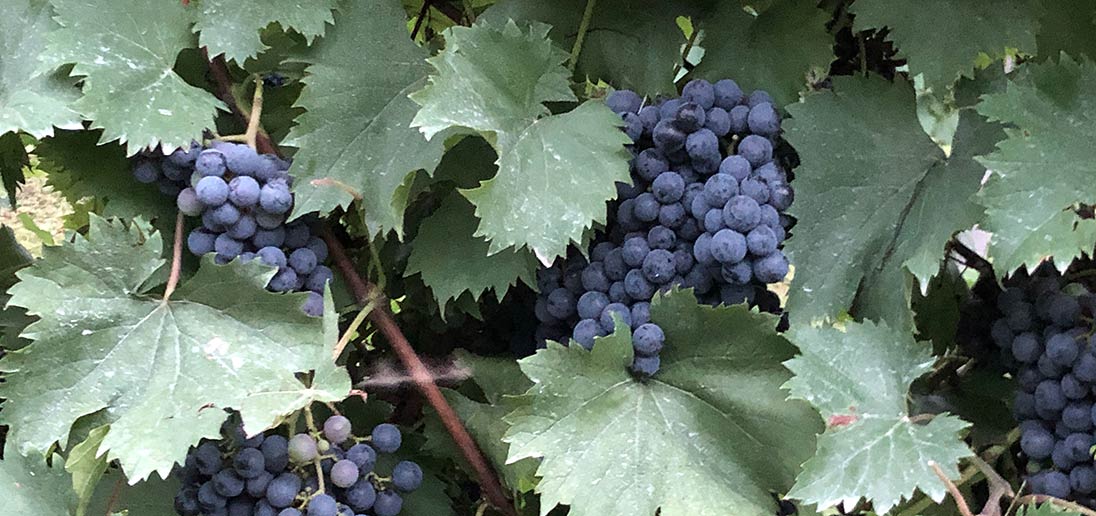We believe that “Wine is Made in the Vineyard”, and that high quality grapes are the first step toward making great wine. Our vineyards are located in the Cumberland Valley viticulture area and currently include the hybrid varieties’ Vidal Blanc, Corot Noir, Chambourcin, Traminette and Chardonel and the American varieties Concord and Niagara. We also grow much of the fruit that is utilized in our line of country wines, including blackberries, elderberries, and blueberries. Other fruit is sourced locally.
We practice sustainable agriculture which seeks to support our farmers while maintaining environmentally sound practices. To this end, we focus on grape varieties suited to this growing region, which greatly reduces our dependence on sprays. A judicious use of mulch helps retain water, supply vital nutrients, and suppresses weeds. The grapes are carefully hand pruned to allow optimal sunshine and airflow, which is important for disease management.
At harvest time, grapes are hand-picked early in the morning while still cool, and processed the same day to preserve the full flavor profile of the grape.
Grape Varieties
Chambourcin
This blue grape is a French American hybrid developed by Joannes Seibel in the Loire Valley of France. It is a winter hardy variety that grows well in the Mid-Atlantic states. The large, moderately loose bunches set medium-sized blue berries. Chambourcin is versatile for wine making, producing wines that are fruity with somewhat spicy undertones. Young wine can have a rather fruity flavor, as it ages it evolves into a mature wine characterized by caramel and chocolate flavors. (Chambourcin wines are often served with dark chocolate.)
Chardonel
This hybrid grape was the fourth grape produced by the New York State Agricultural Experiment Stations by crossing the hybrid Seyval with the classic viniferal variety Chardonnay in 1953. It is considered colder hardy than its parent Chardonnay, and produces green grapes with large clusters. This white wine grape produces excellent wines with a clean and crisp Chardonnay character.
Concord
(Vitis labrusca) Concord grapes were developed 1849 in Concord, Massachusetts by Ephraim Bull. The original vine he selected is still growing at his former house. Concord is considered a Vitis labrusca cultivar, though some believe that it may have been cross fertilized with a Catawba grape. Concord is the most famous American grape with vigorous, hardy and productive vines. Concord grapes are used as table grapes, juice and jelly grapes as well as wine grapes. They are tough skinned, flavorful and highly aromatic grapes with a distinct “foxy” flavor.
Corot Noir
This hybrid grape was developed at the Cornell University Agricultural Experiment Station and released in 2006. The parent grapes are the hybrids Seyve Villard 18-307 and Steuben. The vines are moderately winter hardy and resistant to fungal diseases. This variety is used in varietal red wine production or for blending. The distinctive wine has a deep red color with fruity berry and cherry aromas.
Niagara
(Vitis labrusca) This versatile North America grape in addition to making wine, is used as table grapes, jams and juice. The Niagara grape was created by Claudius L. Hoag and Benjamin W. Clark in Niagara County, New York, in 1868. It is a cross between Concord grapes and white Cassady grapes. Niagra grapes are large, round to oval-shaped and pale greenish-white in color. Wines produced are sweet and pleasant with a “foxy” flavor described as candied lemon rind, a Riesling-like diesel aroma, and flowery jasmine-like notes.
Traminette
This hybrid white wine grape resulted from the cross of the Joannes Seyve 23.416 grape and Gewürztraminer in 1965, and it was released in 1996. Grapes are disease resistant and cold hardy and grow well in Pennsylvania. Wines are finished dry or semi dry depending on preferred style, and have a pronounced varietal character likened to Gewürztraminer
Vidal Blanc
Another commonly grown variety for the Mid-Atlantic region, Vidal Blanc is a white wine variety that exhibits good cold hardiness and is well suited for a variety of climatic and soil conditions. Vidal Blanc was developed in the 1930s by French breeder Jean Louis Vidal by crossing “parents” Ugni Blanc and Seibel. (Ugni Blanc is also known as Trebbiano, a white grape used mainly for brandy production in France and for Chianti blending in Italy) . Vidal Blanc produces small berries borne on very large, tapering clusters. The grapes tend to produce high sugar levels in cold climates while maintaining good acid levels. Vidal Blanc can be made into a variety of wine styles, including off-dry Germanic style wine, sparkling wine, dry barrel-fermented table wines, and late harvest sweeter dessert wines.





